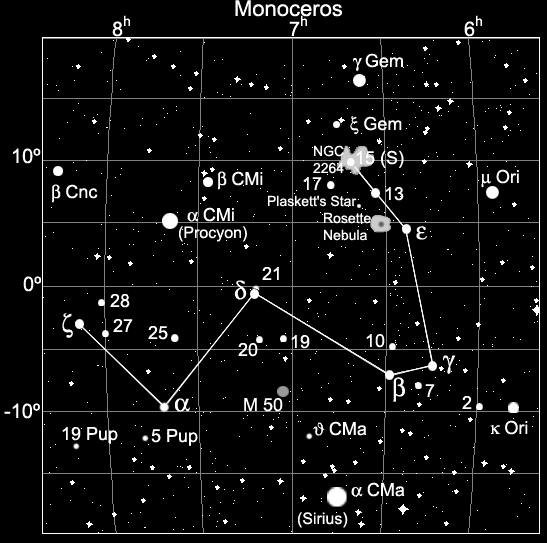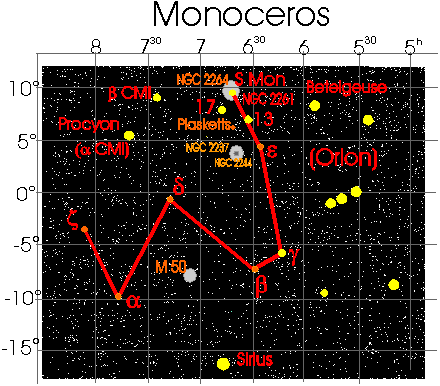
Although neglected due to its proximity with Orion and because its stars are quite faint, Monoceros offers several interesting objects for binoculars. However, a study of Canis Minor is recommended first.

Alpha Monocerotis is an orange giant 144 light years. The brightest star in Monoceros, it is only 3.94 visual magnitude.
Finding alpha Monocerotis shouldn't be difficult on a clear dark night. Using the naked eye, start at Procyon (alpha Canis Major), which you should have read about before visiting Monoceros. Alpha Monocerotis is fifteen degrees (two binocular FOV) due south of Procyon. You can also draw a line between Procyon and Sirius, to the southwest. Now proceed down this line from Procyon two-thirds the distance, then move due east. The brightest star you'll encounter is alpha Monocerotis. You'll note that you're nearly into Puppis, to the south. Now, using the same method, go back to that line you drew. Instead of moving east to alpha, move west to beta, about the same distance and just a degree or two north.
Beta Mon is a superb triple system for small telescopes -- three white stars in the form of a soft curve: 4.6, 5.0, 5.4. The stars are 690 light years away. The binary is the starting point for visiting the various deep sky objects, which are due north. But before we go north, the rest of the southerly stars should be pointed out. With the naked eye, from beta sweep slowly toward Procyon. A little over half way we come to delta.
Delta Mon is a 4th-magnitude star 115 light years away, which makes it pretty typical for the stars of this constellation. It is found a little over half way between beta Monocerotis and Procyon. If you now study this region closely with the naked eye, you'll find that Procyon, alpha, and delta form a small asterism, a somewhat skewed square. The other corner of this square, to the east, is zeta Monocerotis.
Zeta Mon makes a tilted square along with delta, alpha, and Procyon. The binocular view shows three faint attendants to the west. As you can see, zeta is very near the border with Hydra. Now that the southern members of the constellation have been met, we'll proceed to investigate the deep sky objects. From beta Monocerotis travel due north one and a half binocular fields to epsilon.
Epsilon Mon is the second brightest star of the constellation, at 4.0 visual magnitude. More importantly, it's a convenient way of finding the constellation's very interesting deep sky objects. To find epsilon, with beta and gamma Monocerotis in your field of view move due north eleven degrees, or one and a half binocular fields. You'll note a bright star to the northeast. This is 13 Mon, a useful star for hopping over to S Monocerotis later. Also in the same field as epsilon, just to the east, is the renowned deep sky object The Rosette Nebula, as well as its associated star cluster NGC 2244. Plaskett's Star is in the same FOV.
